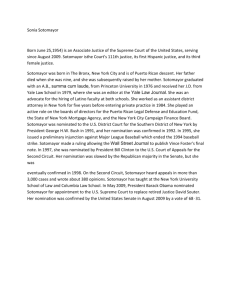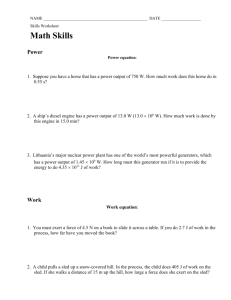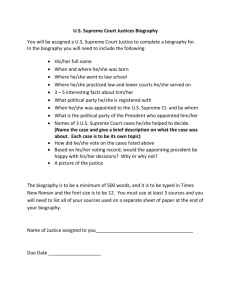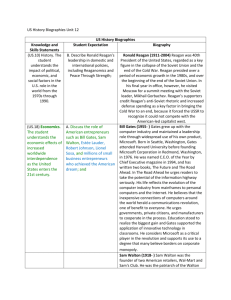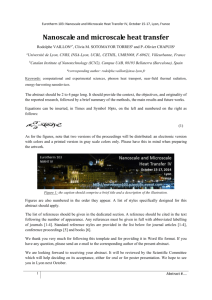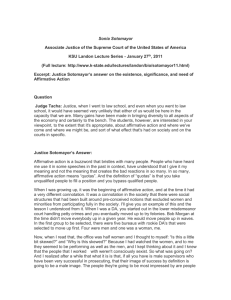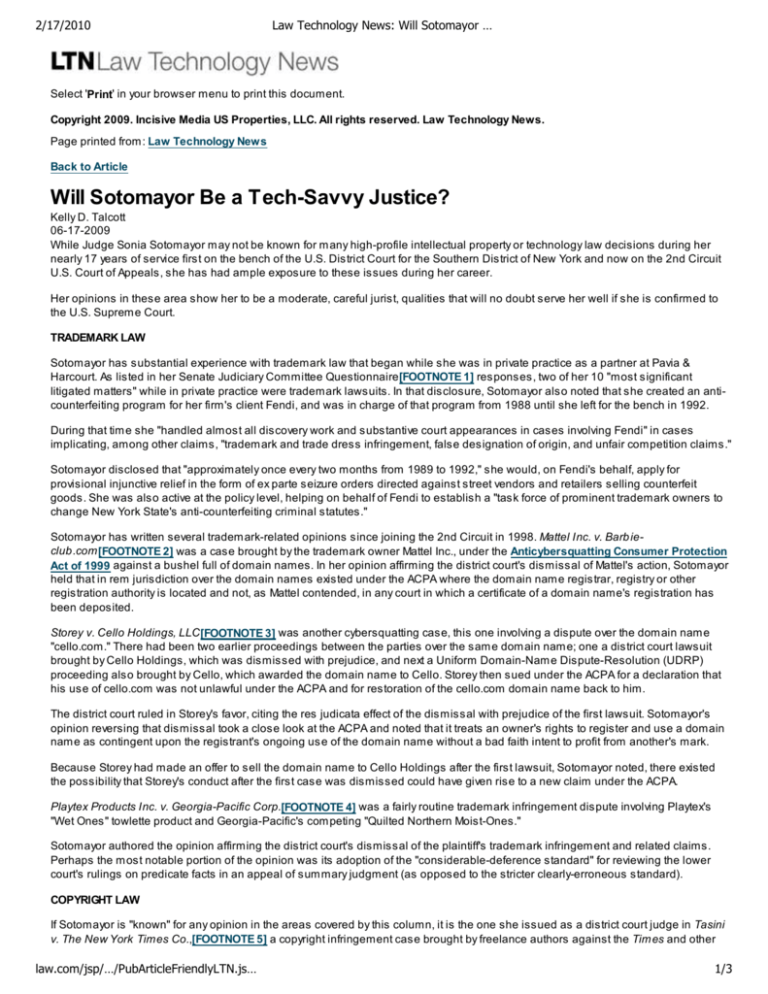
2/17/2010
Law Technology News: Will Sotomayor …
Select 'Print' in your browser menu to print this document.
Copyright 2009. Incisive Media US Properties, LLC. All rights reserved. Law Technology News.
Page printed from : Law Technology News
Back to Article
Will Sotomayor Be a Tech-Savvy Justice?
Kelly D. Talcott
06-17-2009
While Judge Sonia Sotomayor m ay not be known for m any high-profile intellectual property or technology law decisions during her
nearly 17 years of service first on the bench of the U.S. District Court for the Southern District of New York and now on the 2nd Circuit
U.S. Court of Appeals, she has had ample exposure to these issues during her career.
Her opinions in these area show her to be a moderate, careful jurist, qualities that will no doubt serve her well if she is confirmed to
the U.S. Suprem e Court.
TRADEMARK LAW
Sotomayor has substantial experience with trademark law that began while she was in private practice as a partner at Pavia &
Harcourt. As listed in her Senate Judiciary Committee Questionnaire[FOOTNOTE 1] responses, two of her 10 "most significant
litigated matters" while in private practice were trademark lawsuits. In that disclosure, Sotomayor also noted that she created an anticounterfeiting program for her firm's client Fendi, and was in charge of that program from 1988 until she left for the bench in 1992.
During that tim e she "handled almost all discovery work and substantive court appearances in cases involving Fendi" in cases
implicating, among other claims, "tradem ark and trade dress infringement, false designation of origin, and unfair competition claims."
Sotomayor disclosed that "approximately once every two months from 1989 to 1992," she would, on Fendi's behalf, apply for
provisional injunctive relief in the form of ex parte seizure orders directed against street vendors and retailers selling counterfeit
goods. She was also active at the policy level, helping on behalf of Fendi to establish a "task force of prominent trademark owners to
change New York State's anti-counterfeiting criminal statutes."
Sotomayor has written several tradem ark-related opinions since joining the 2nd Circuit in 1998. Mattel Inc. v. Barb ieclub.com[FOOTNOTE 2] was a case brought by the trademark owner Mattel Inc., under the Anticybersquatting Consumer Protection
Act of 1999 against a bushel full of domain names. In her opinion affirming the district court's dismissal of Mattel's action, Sotomayor
held that in rem jurisdiction over the domain names existed under the ACPA where the dom ain nam e registrar, registry or other
registration authority is located and not, as Mattel contended, in any court in which a certificate of a domain name's registration has
been deposited.
Storey v. Cello Holdings, LLC[FOOTNOTE 3] was another cybersquatting case, this one involving a dispute over the dom ain nam e
"cello.com." There had been two earlier proceedings between the parties over the sam e dom ain nam e; one a district court lawsuit
brought by Cello Holdings, which was dismissed with prejudice, and next a Uniform Domain-Nam e Dispute-Resolution (UDRP)
proceeding also brought by Cello, which awarded the domain name to Cello. Storey then sued under the ACPA for a declaration that
his use of cello.com was not unlawful under the ACPA and for restoration of the cello.com domain name back to him.
The district court ruled in Storey's favor, citing the res judicata effect of the dismissal with prejudice of the first lawsuit. Sotomayor's
opinion reversing that dismissal took a close look at the ACPA and noted that it treats an owner's rights to register and use a domain
nam e as contingent upon the registrant's ongoing use of the domain name without a bad faith intent to profit from another's mark.
Because Storey had made an offer to sell the domain name to Cello Holdings after the first lawsuit, Sotomayor noted, there existed
the possibility that Storey's conduct after the first case was dismissed could have given rise to a new claim under the ACPA.
Playtex Products Inc. v. Georgia-Pacific Corp.[FOOTNOTE 4] was a fairly routine trademark infringement dispute involving Playtex's
"Wet Ones" towlette product and Georgia-Pacific's com peting "Quilted Northern Moist-Ones."
Sotomayor authored the opinion affirming the district court's dismissal of the plaintiff's trademark infringem ent and related claims.
Perhaps the m ost notable portion of the opinion was its adoption of the "considerable-deference standard" for reviewing the lower
court's rulings on predicate facts in an appeal of sum mary judgment (as opposed to the stricter clearly-erroneous standard).
COPYRIGHT LAW
If Sotomayor is "known" for any opinion in the areas covered by this column, it is the one she issued as a district court judge in Tasini
v. The New York Times Co.,[FOOTNOTE 5] a copyright infringement case brought by freelance authors against the Tim es and other
law.com/jsp/…/PubArticleFriendlyLTN.js…
1/3
2/17/2010
Law Technology News: Will Sotomayor …
periodicals arising out of the republication of their articles in electronic databases and on CD-ROMs. At issue was the following
language of section 201(c) of the Copyright Act:
In the absence of an express transfer of the copyright or of any rights under it, the owner of copyright in the collective
work is presum ed to have acquired only the privilege of reproducing and distributing the contribution as part of that
particular collective work, any revision of that collective work, and any later collective work in the same series.
Sotomayor held that this language gave publishers the privilege of reissuing or revising collective works, and did not lim it the
republication right to the original m edium.
The 2nd Circuit reversed, disagreeing with Sotom ayor's interpretation of §201(c), and the U.S. Supreme Court eventually affirmed that
ruling. Both courts agreed that because the electronic databases reproduced and distributed individual articles standing alone and
not in context, or as "part of that particular collective work" to which any of the authors contributed, or as a "revision of that collective
work," or as a "later collective work in the same series," the Times and other publishers were not protected from copyright
infringem ent claims by §201(c).
PATENT LAW
Sotomayor's experience with patent cases while a member of the 2nd Circuit has necessarily been limited to other types of cases,
such as antitrust, that touch on patent issues. As a district court judge, however she handled a number of patent disputes, two of
which found their way to the Federal Circuit on appeal.
REFAC Int'l, Ltd. v. Lotus Development Corp.[FOOTNOTE 6] involved a patent for a method of converting a software source code
program to object code. Sotomayor held that the patent was unenforceable because one of the affidavits used during prosecution to
overcome the exam iner's objection and secure allowance failed to disclose a number of substantial connections between the affiant
and the inventor's company.
The Federal Circuit noted that, while the usual inequitable conduct claim is based on a failure to disclose relevant prior art or an
affirmative misrepresentation, Sotomayor had made findings based on evidence that the omissions in this case were material and
were intended to deceive. Accordingly, there was no abuse of discretion.
In Dow Corning Wright Corp. v. Biomet Inc.,[FOOTNOTE 7] a pre-Festo decision, Sotomayor denied the defendant's motion for
sum mary judgm ent of non-infringement, disagreeing that prosecution history estoppel limited the patent's scope.
In that case, during prosecution, Dow Corning Wright Corp. had responded to an exam iner's claim rejection based on the prior art by
combining the rejected independent claim and the subsequent dependent claim. Dow maintained in the prosecution that in so doing
it was merely actually com bining two claims that would otherwise be im pliedly combined under the law.
Sotomayor accepted Dow's argum ent and refused to apply prosecution history estoppel to the enforcement of the asserted claim.
The judge was for a time involved in Intellectual Property Development Inc. v. UA-Colum b ia Cab levision of Westchester Inc., where
she construed the disputed claim term "high frequency carrier" as being in "the VHF range, 54 to 216 MHz." The case was later
transferred to the U.S. District Court for the Central District of California, which subsequently returned it to the district court in the
Southern District of New York, where it was then assigned to Judge Pauley because Sotomayor had since been elevated to the 2nd
Circuit.
The defendants moved for reconsideration of Sotomayor's construction of "high frequency carrier;" Pauley granted the motion, and it
was his construction of that claim term (3 to 30 MHz) that was eventually affirm ed by the Federal Circuit (though his finding of invalidity
was reversed).
WORKPLACE PRIVACY
In Leventhal v. Knapek,[FOOTNOTE 8] an employee of the New York State Departm ent of Transportation appealed the district court's
dismissal of his lawsuit claiming that a workplace search of his office computer violated his Fourth Amendm ent rights.
In her opinion, Sotom ayor balanced the em ployee's limited expectation of privacy, the DOT's legitimate need to investigate allegations
of the employee's misconduct, and the "modest intrusion" presented by the search.
While the DOT had not placed the employee on notice that his office computer was subject to search at any time, the IT staff did
occasionally access the computer for service-related work. Because the search of the employee's computer was "reasonably related"
to its investigation of his alleged m isconduct, and because the search was not "excessively intrusive," Sotomayor found that the
searches did not violate his rights.
ELECTRONIC CONTRACTS
Sotomayor penned the opinion in Specht v. Netscape Communications Corp.,[FOOTNOTE 9] one of the earlier cases involving
Internet-based agreem ents.
The plaintiffs in Specht were individuals com plaining of privacy violations caused by plug-in software they downloaded from
law.com/jsp/…/PubArticleFriendlyLTN.js…
2/3
2/17/2010
Law Technology News: Will Sotomayor …
defendants' Web site. The defendants attempted to enforce an arbitration clause included as part of the software license relating to
the downloads, and the district court denied the motion. The 2nd Circuit affirmed, with Sotomayor writing the opinion.
The ruling was based on lack of reasonable notice. The software license was displayed below the "Download" button on the Web
page in such a way that users would have to scroll down to review it. Sotomayor held that "where consumers are urged to download
free software at the click of a button, a reference to the existence of license terms on a submerged screen is not sufficient to place
consumers on inquiry or constructive notice of those terms."
In an interesting aside, Sotomayor discussed whether the dispute involved the individual plaintiffs' intellectual property rights (to
determine whether the arbitration clause's exclusion for disputes relating to IP rights might be implicated). She considered, and
discarded, the idea that the plaintiffs' personal inform ation could be protected by copyright, "trade secrets, good will, or other valuable
intangibles," but in the end stated that it was "not an issue that we decide today."
CONCLUSION
Sotomayor would bring to the U.S. Supreme Court a strong background in tradem ark and anti-counterfeiting law and a familiarity with
the other m ajor areas of IP and technology law that would be an asset to a Court that has becom e increasingly tech-savvy.
Kelly D. Talcott, a partner in the New York office of Edwards Angell Palmer & Dodge, practices intellectual property and technology law.
::::FOOTNOTES::::
FN1 Available as of June 10, 2009 at http://judiciary.senate.gov/nominations/SupremeCourt/Sotomayor/SoniaSotomayorQuestionnaire.cfm.
FN2 Mattell Inc. v. Barbie-club.com , 310 F.3d 293 (2nd Cir. 2002).
FN3 Storey v. Cello Holdings, LLC, 347 F.3d 370 (2nd Cir. 2003).
FN4 Playtex Products Inc. v. Georgia-Pacific Corp. , 390 F.3d 158 (2nd Cir. 2004).
FN5 Tasini v. The New York Times Co. , 972 F.Supp. 804 (S.D.N.Y. 1997).
FN6 REFAC Int'l, Ltd. v. Lotus Development Corp. , 887 F.Supp. 539 (S.D.N.Y. 1995).
FN7 Dow Corning Wright Corp. v. Biomet Inc. , 1993 WL 60571 (S.D.N.Y. 1993).
FN8 Leventhal v. Knapek, 266 F.3d 64 (2nd Cir. 2001).
FN9 Specht v. Netscape Communications Corp. , 306 F.3d 17 (2nd Cir. 2002).
law.com/jsp/…/PubArticleFriendlyLTN.js…
3/3
This document was created with Win2PDF available at http://www.win2pdf.com.
The unregistered version of Win2PDF is for evaluation or non-commercial use only.
This page will not be added after purchasing Win2PDF.

